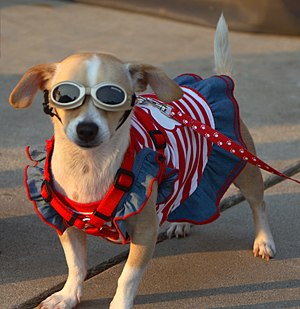Whether humans or animals we’re stuck in our own reality. How we experience the world is always through our own perspective. Because we’re curious beings or just trying to survive, we naturally put effort in trying to understand the world around us. Science is born from our need to put sense to the world around us in the most objective way, but when we don’t have data to interpret what we see, we fill in the gaps and project our own thoughts and feelings. Dogs can’t talk, so we can’t ask them what they think or how they feel, we can only watch their reactions and interpret them the best we can. Most owners aren’t scientists or dog experts and develop deep emotional connections with their animals similar to those of a parent and a child. It’s only natural then to project human thoughts and feelings in their pooches mind. This process is called anthropomorphism, which translated from Greek means putting human form or characteristics to something non-human. Unfortunately, this natural process has also contributed in the development of many problems, leading to misunderstandings and abuse. As science uncovers more and more similarities between how humans and dogs think and feel, could the confusion between knowledge and projection get even bigger? Could those findings validate our projections on our dogs as well as our tendencies to treat them as small yet furry versions of humans?
Dogs are overweight from people feeling guilty about eating in front of their dog unless they can share their food with them. Millions of dogs are kept intact because of how owners (mostly men) think their dog would feel if their family jewels were removed. Dog owners (also referred to as dog parents) believe that their furry companion has purposely peed on the new carpet as an expression of their anger for being left alone for so long. In the same way, many believe their dog feels guilty when they come back and uncover the dirty and smelly deed. Many behavior problems in dogs stem from the effects of anthropomorphizing. We treat our dogs like babies, we overestimate their capacity to understand our language, oversimplify, project, develop expectations and often fail to see the dog as he/she really is.
With such effects in the human/dog relationship, it’s understandable that anthropomorphizing has been on the radar of many dog professionals who’s main job is to educate owners and bring them to a more realistic interpretation of their dogs’ behavior. But anthropomorphizing is not all bad. In many ways, it has also contributed in our bond with these animals. We do understand each other naturally, even if it’s only to a point. We also love dogs because we think we understand them and see in them expressions of love and loyalty. We get teary eyed watching Lassie, Benjie and Beethoven save their owners from difficult situations and show compassion and affection. It doesn’t matter that their behavior is unrealistic. We believe it enough to buy into the stories.
When we look at the evolution of dog training, it’s quite obvious that we’ve always at least attempted to apply scientific findings to our interactions with the animals we interact with. The dominance or pack theory came from our best knowledge, at the time, of canine behavior. Behind the concept was the desire to respect the dogs’ values and perception of the world. But like any other theory, it’s also important to stay up to date as the scientific findings progress. Just like in this case, new findings sometimes disprove older conclusions in light of new facts.
For the longest time, anthropomorphizing has been taboo in the scientific world where only facts and observable data have their place. Labeling behaviors as expressions of emotions was at one’s own risk of being ridiculed. Scientists and philosophers went from believing that animals could not experience emotions and were merely little robots only reacting from instincts and reflexes to finally believing in the richness of the animals’ emotional lives. It’s undeniable. Having the same brain structures as we do, as well as the same chemistry, it’s hard to deny their abilities to experience the world in similar ways. The differences are in degrees, not in abilities. So how similar are they?
Research seems to indicate that the dogs’ mind can be compared to that of a 2 ½ year old child with the ability to experience most of the humans emotions (Coren, 2013). It’s unlikely however that dog also feels the more complex emotions, such as shame, pride, guilt or contempt. Horn & al. (2013), but also Horowitz and Panksepp (2012) have shown how similar dogs are to children when it comes to feeling and reacting to certain situations. Bekoff pushes the argument even further, claiming that in our attempts to stay away from anthropomorphizing, we also limit our ability to see the animal’s expressions of emotional and moral intelligence (Bekoff & Pierce, 2009). Don’t miss the video of Bekoff on the subject below.
What are the implications of these findings on our interactions with our pooches? With the scientific experts recognizing how close dogs and humans really are, we can now validate many of the anthropomorphic interpretations we had always been subject to. Let’s keep in mind that having similar brains does not mean that we’re the same. We may experience fear, joy and anger, but that doesn’t mean that we’ll interpret all situations in the same way. We still don’t share the same taste for dead carcasses, a smelly patch of grass or a good book. Dogs and humans have the ability to understand each other on many levels, but there is plenty of room for subjective interpretation. The best way to show animals love, is to first respect their differences and allowing them to fulfill their own set of needs without imposing ours beyond their tolerance level. Dressing dogs up and carrying them like babies, for example, may fill our need for caring and nurturing, but it’s at the cost of the dog’s ability to explore and socialize like a dog. In the same way, pinning the dog down gives us feelings of power and control, but bears no benefit to the dog, quite the contrary. The best gift a dog parent can provide their beloved pooch is to take the time to learn about their needs, their likes and dislikes and respect them for what they really are, not for what we want them to be.
Jennifer Cattet, Ph.D.
Related articles







Jennifer, thanks for the blog. Love your insight. You are a great writer. Will be sharing with my students.
Love your articles and insights!
I used to apologize for anthropomorphizing and wouldn’t do it in front of my dog training colleagues. Now, though, I find it breaks the ice and provides a way to help explain how dogs learn when I anthropomorphize “smartly” with my dog-loving clients. Seeing things from the perspective of their dog (put in human terms) frequently helps them understand that their dog isn’t stubborn, that they really haven’t taught their dog what they think they have.
So I’ve gone from never to sometimes. And to tell you the truth, when it’s just my husband and me, we actually make up “think bubbles” above the dogs’ heads and laugh like crazy at what it *looks* like the dogs might say.